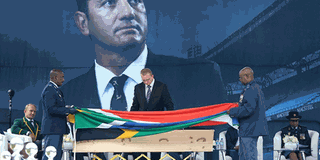Mourners honour South African legend Van der Westhuizen

The South African flag is laid on the coffin of former South African rugby player Joost van der Westhuizen during a memorial service at Loftus rugby stadium on February 10, 2017 in Pretoria, South Africa. The former scrum-half, a Springboks captain who won the 1995 World Cup, died on February 6 aged 45 after a five-year battle with motor neurone disease which left him frail and in a wheelchair. PHOTO | STRINGER |
What you need to know:
- Teammates from South Africa's 1995 World Cup winning squad carried the coffin of Joost van der Westhuizen into his memorial service on Friday in front of several hundred mourners.
- Van der Westhuizen, hailed as one of the greatest rugby players of the modern era, died on Monday aged 45 after a long and public battle with motor neurone disease.
- Francois Pienaar led the coffin-bearers at Pretoria's Loftus Versfeld stadium, where prolonged rounds of applause broke out to honour the celebrated scrum-half.
PRETORIA
Teammates from South Africa's 1995 World Cup winning squad carried the coffin of Joost van der Westhuizen into his memorial service on Friday in front of several hundred mourners.
Van der Westhuizen, hailed as one of the greatest rugby players of the modern era, died on Monday aged 45 after a long and public battle with motor neurone disease.
Francois Pienaar led the coffin-bearers at Pretoria's Loftus Versfeld stadium, where prolonged rounds of applause broke out to honour the celebrated scrum-half.
"Joost loved winning. He was the ultra competitor," Pienaar, captain of the 1995 team that collected the World Cup from Nelson Mandela, told mourners.
"In the days of amateur rugby, Joost van der Westhuizen had a professional mindset and discipline.
"On the field he played like a rock star, and off the field he partied like a rock star because he was after all a rock star.
"He was funny and naughty... and always, always smiling."
First capped by the Springboks in 1993, van der Westhuizen made 89 international appearances and scored 38 tries as scrum-half, a position that he is credited with transforming single-handedly.
'SET THE BENCHMARK'
"Not only was he extremely determined, competitive and skilful... He set the benchmark for the modern player. He set the standard that everybody else followed."
Van der Westhuizen was diagnosed with motor neurone disease, which damages the nervous system, in 2011, gradually becoming confined to a wheelchair and a shadow of his athletic former self.
He was given two to five years to live when diagnosed.
In 2015, a fragile Van der Westhuizen joined fellow 1995 World Cup champions at Ellis Park Stadium for an event to commemorate 20 years since the team's historic victory.
He was renowned for his fearless tackles on Jonah Lomu in that game and setting up the Joel Stransky drop goal which won the cup for the Springboks, just one year after South Africa's first democratic elections.
Van der Westhuizen's wife singer Amor Vittone, who supported him through his illness despite the couple being separated, paid an emotional tribute to the father of their two children.
She remembered him as a "handsome man with the most beautiful eyes and with goals, ambitions and a dynamic mindset... he swept me off my feet."
"In the last seven years he fought so bravely with this awful, horrible disease... the main reason I think that he fought so hard was that he wanted to be there for his children."
Van der Westhuizen set up the J9 Foundation to promote awareness of motor neurone disease, using the number 9 from his shirt number.





